Invention, Intellectual Property and Income
Objectives for Week 18
- Develop a plan for dissemination of the final project
- Prepare drafts of summary slide and video clip and put them in root directory
Invention
In the context of intellectual property (IP), an invention refers to a novel and useful idea, method, process, device, or composition of matter that is eligible for legal protection under patent law. Patents grant inventors exclusive rights to their inventions for a limited period, typically 20 years from the filing date of the patent application. To qualify for a patent, an invention must meet certain criteria, including novelty (it must be new and not disclosed to the public before filing), non-obviousness (it must not be an obvious improvement over existing technology), and utility (it must have a practical application). Inventions can cover a wide range of innovations, from new products and processes to improvements on existing technologies. Inventions can encompass a broad spectrum of advancements, which may include:
- New Products: Innovations that result in the creation of tangible items previously non-existent, such as machinery, electronic devices, or pharmaceutical drugs.
- Processes and Methods: Novel approaches to conducting activities, such as manufacturing techniques, business methods, or medical procedures.
- Compositions of Matter: Original formulations or combinations of substances, such as chemical compounds, materials, or compositions used in various applications, including medicine, industry, or agriculture.
These categories highlight the diverse nature of inventions, encompassing both physical products and intangible methods or compositions that contribute to technological progress and economic development.
Intellectual Property
Intellectual property (IP) refers to creations of the mind, such as inventions, literary and artistic works, designs, symbols, names, and images used in commerce. IP is protected by law through patents, copyrights, trademarks, and trade secrets. Here are the main types of intellectual property:
- Patents: Patents grant inventors exclusive rights to their inventions, preventing others from making, using, selling, or importing the invention without permission. Patents typically cover inventions like new products, processes, or improvements thereof, and are granted for a limited period, usually 20 years from the filing date.
- Copyrights: Copyrights protect original works of authorship fixed in a tangible medium, such as literary, artistic, musical, and dramatic works, as well as computer software and architectural designs. Copyright owners have the exclusive right to reproduce, distribute, perform, display, and create derivative works of their creations. Copyright protection generally lasts for the author's lifetime plus 70 years.
- Trademarks: Trademarks are used to protect words, phrases, symbols, logos, or other devices that distinguish the source of goods or services from those of others. Trademark rights allow owners to prevent unauthorized use of their marks in commerce and to build brand recognition. Trademark protection can potentially last indefinitely as long as the mark is in use and properly maintained.
- Trade Secrets: Trade secrets are confidential business information that provides a competitive advantage. They can include formulas, patterns, compilations, programs, devices, methods, techniques, or processes that are kept secret and not generally known or readily ascertainable by others who could obtain economic value from its disclosure or use. Unlike patents, trademarks, and copyrights, trade secrets have no fixed term of protection and can potentially last indefinitely as long as they remain secret.
- Industrial Designs: In a legal sense, an industrial design constitutes the ornamental aspect of an article. An industrial design may consist of three dimensional features, such as the shape of an article, or two dimensional features, such as patterns, lines or color.
- Geographical Indications: A geographical indication (GI) is a sign used on products that have a specific geographical origin and possess qualities or a reputation that are due to that origin. In order to function as a GI, a sign must identify a product as originating in a given place.
Intellectual Property Rights Registration in India
In India, the intellectual property rights pertaining to trademarks and patents are controlled by the Controller General of Patents Designs and Trademarks, Department of Industrial Policy and Promotion, Ministry of Commerce and Industry. Copyrights are handled by the Copyright Office, Copyright Societies, Government of India. Based on the type of intellectual property right to be registered, application must be made to the concerned authorities in the prescribed form. Visit India Briefing to know more about the Laws and Procedures for Registration.
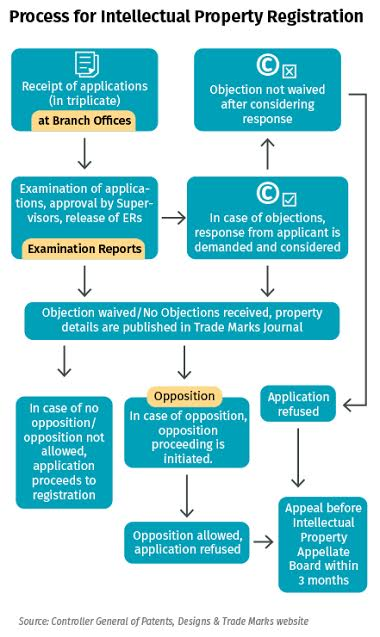
Creative Commons
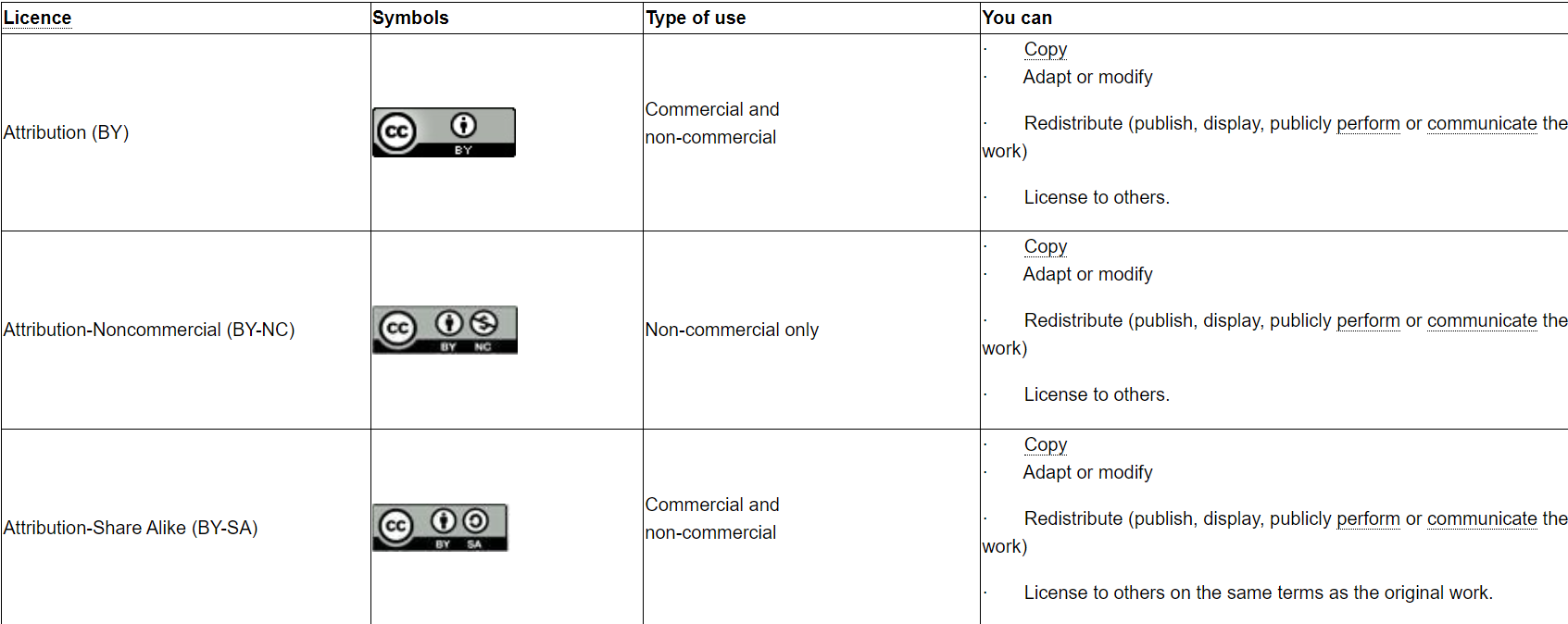

Creative Commons (CC) is a nonprofit organization that provides free, easy-to-use copyright licenses for creators to share their work under specific conditions. These licenses enable creators to give others the permission to use their work in various ways, while still retaining some rights.
User Rights:
- Freedom to Use: Users are granted the right to use the licensed work in various ways, depending on the license conditions chosen by the creator.
- Freedom to Share: Creators can choose to allow others to copy, distribute, and transmit their work.
- Freedom to Remix: Users can create derivative works or remixes of the original work, as long as they comply with the license conditions.
User Obligations:
When using any Creative Commons (CC) licensed material, it's important to adhere to certain requirements and restrictions:
Requirements:
- Attribute the Creator: Always give credit to the creator of the work. This involves providing appropriate attribution according to the guidelines specified in the license.
- Obtain Permission for Beyond-License Uses: If you intend to use the work in ways not permitted by the CC license (e.g., for commercial purposes or creating derivative works when not allowed), you must obtain explicit permission from the creator.
- Maintain Copyright Notices: Ensure that any copyright notices provided by the creator are retained on all copies of the work.
- Link to the License: Include a link to the specific CC license under which the work is licensed, indicating the terms under which the work is used.
- Acknowledge Changes: If you modify the work, acknowledge the original source and indicate that changes have been made.
Restrictions:
- Do Not Alter License Terms
- Do Not Damage Creator's Reputation
- No Endorsement Implication
- No Technological Restrictions
By understanding and adhering to these rights and obligations, both creators and users can effectively utilize Creative Commons licenses to share and collaborate on creative works in a legal and responsible manner while respecting copyright laws. Visit Creative Commons.
Choosing Right License for FLiP
I've decided to use a Creative Commons license for my project because I'm passionate about fostering educational use. My aim is to empower people to freely access and utilize the project's information and files for learning purposes, rather than for making money. This way, I hope to contribute positively to education by encouraging sharing and collaboration in a supportive environment.
I've decided to add the following Creative Commons for my project:

- Attribution (BY): Users must give appropriate credit to the creator, provide a link to the license, and indicate if changes were made. This obligation ensures that the original creator is acknowledged for their work.
- NonCommercial (NC): Users may not use the work for commercial purposes without obtaining permission from the creator. This obligation ensures that creators retain control over how their work is commercially exploited.
- ShareAlike (SA): If users remix, transform, or build upon the work, they must distribute their contributions under the same license as the original. This requirement ensures that derivative works maintain the same openness and freedoms as the original.



How I got the license
- Go to Creative Commons.
- Since I know the license I need, I proceeded with CC BY-NC-SA 4.0.
- I filled all the required details.
- Once completed, I clicked Done and copied the HTML code for my license available at the right side.
- I linked my license to my final project page.
- I also added the license to my presentation slide.

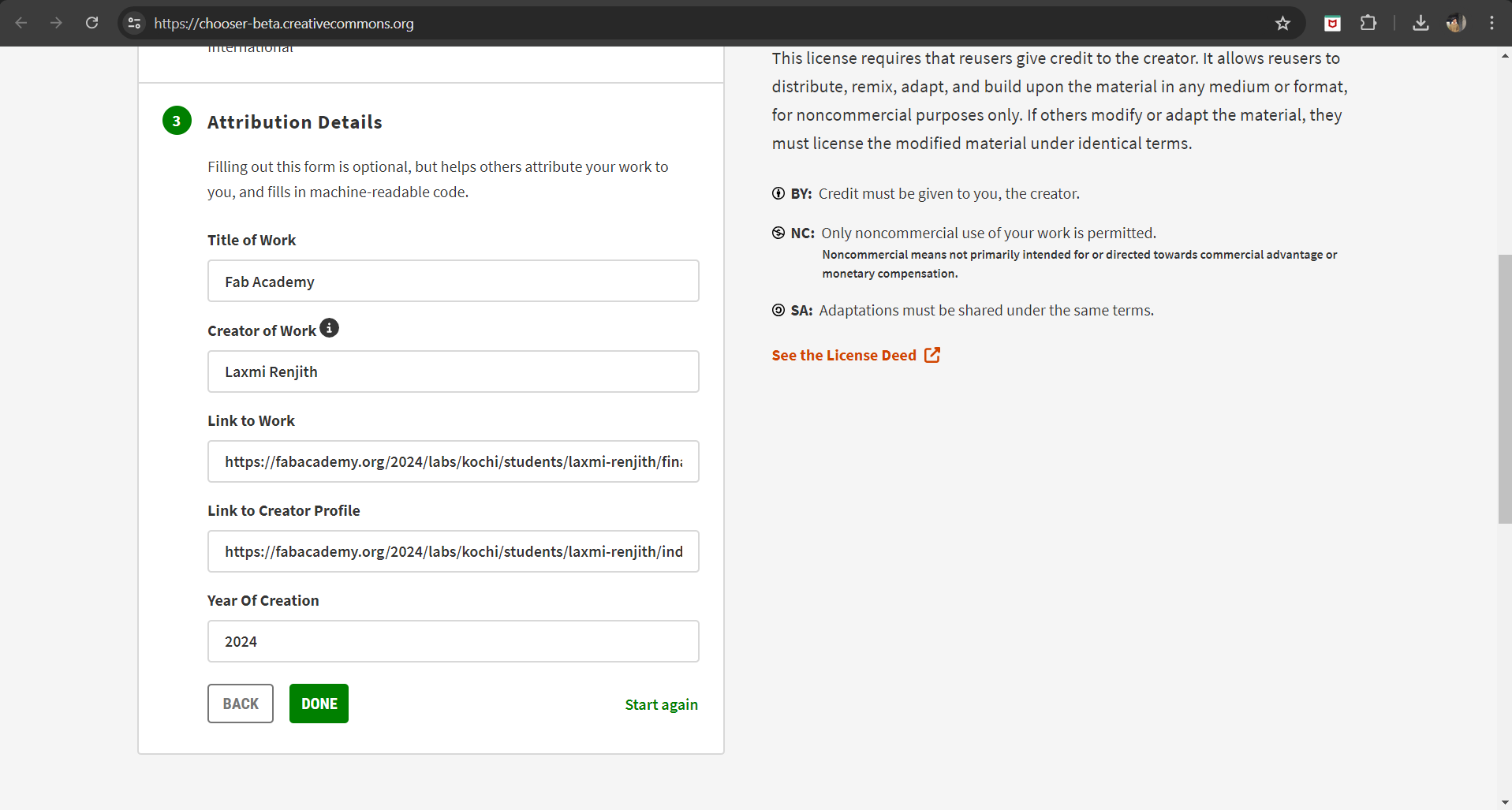
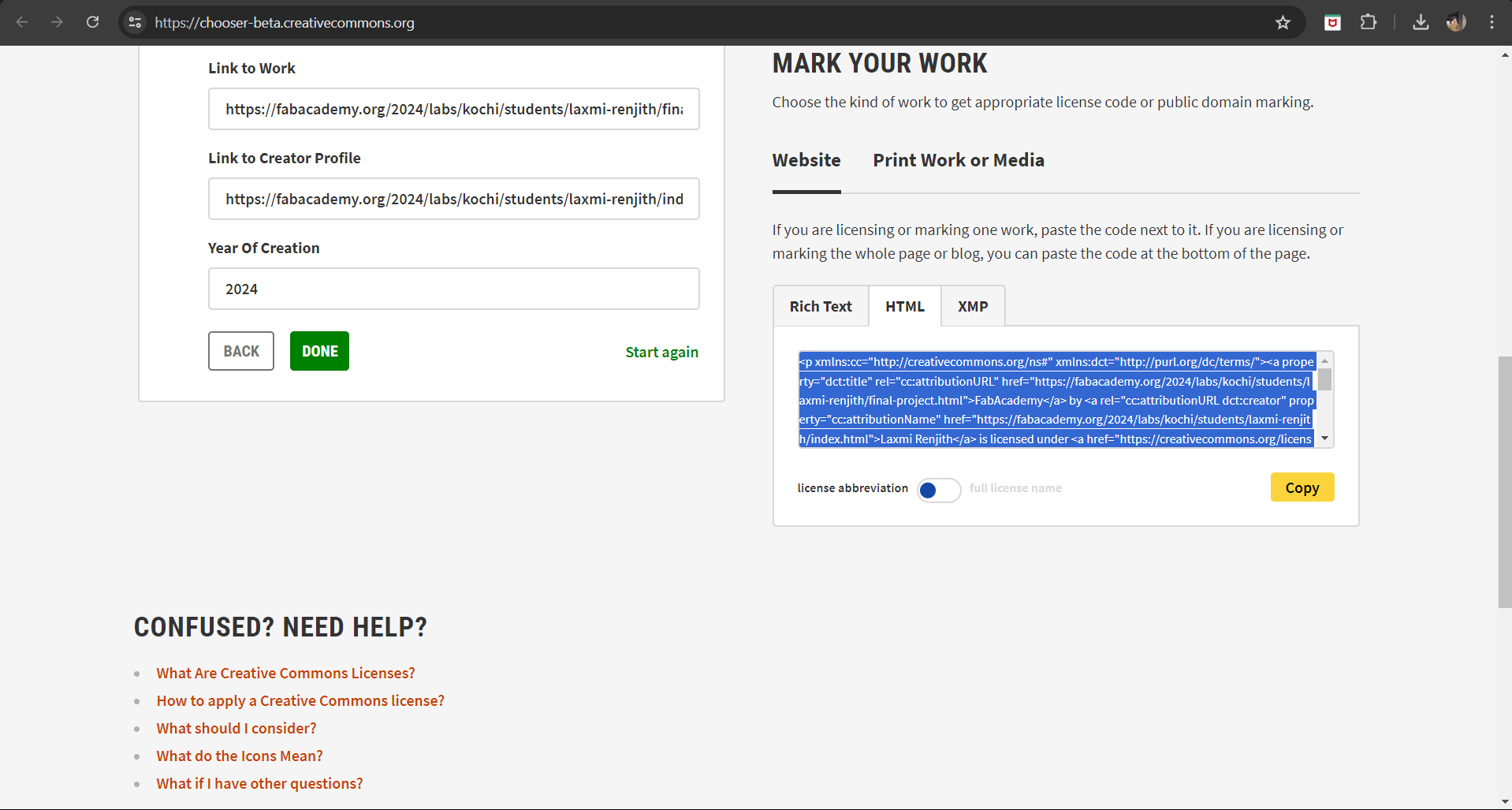
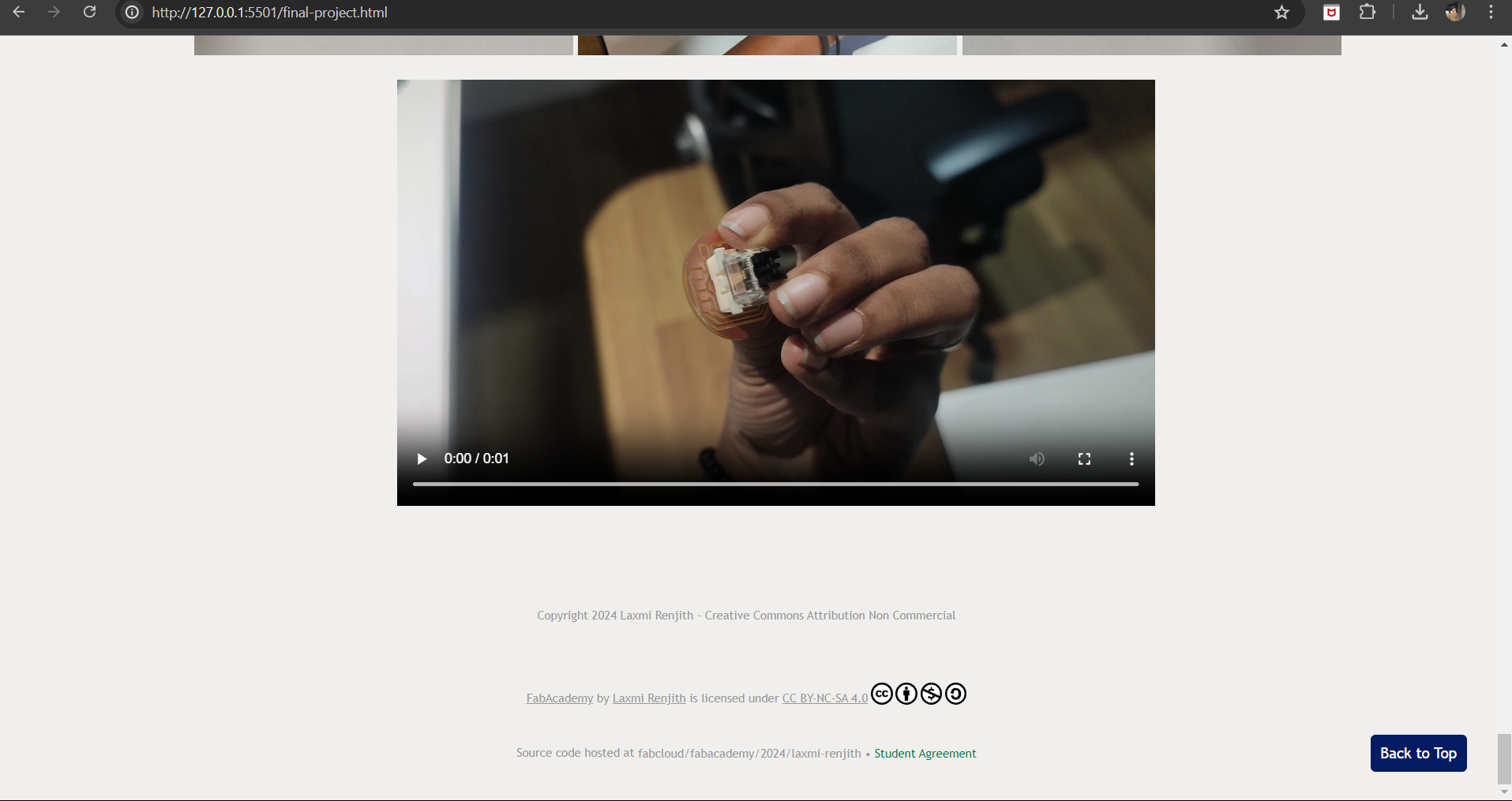

Income
As of now, I am not preparing a business plan out of it. Public can download from the shared platforms and build one of their own.
Sharing Platform
I will be sharing my project in various platforms like GitLab, Fabcloud, Instructables and Youtube.